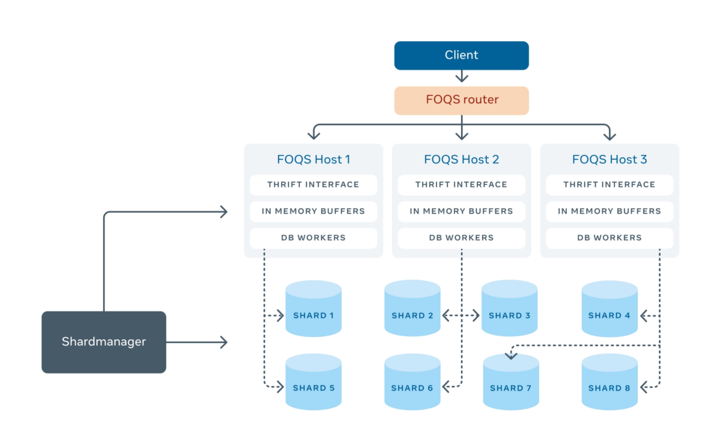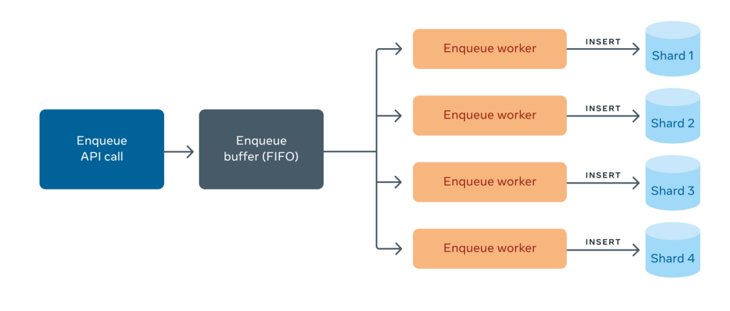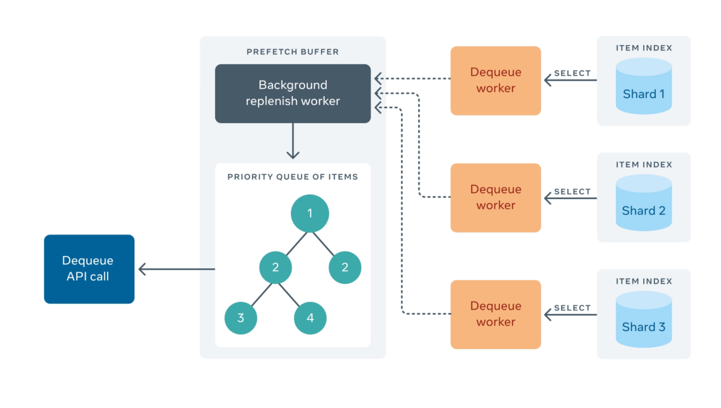FOQS: Scaling a distributed priority queue
A fully managed, horizontally scalable, multitenant, persistent distributed priority queue built on top of sharded MySQL. See here for more details on designing a distributed delay queue.

Why FOQS
Facebook’s distributed systems and microservices benefit from running the workload asynchronously:
- Effective resource utilization.
- Improve system reliability.
- Allow services to schedule compute to execute on a future time.
User stories
- To support Facebook’s Asynchronous computing
- To support video encoding service(Netflix has the similar use case to encode videos asynchronously).
- To support the translation service of i18n. (Design i18n)
Design Details
- Expose Thrift APIs
- Enqueue
- Dequeue
- Ack
- NAck
- GetActiveTopics(Consumer could then dequeue(pull model) the item)
- Using Shard Manager
(Advanced version of Akkio) to manage the shards of a
queue. Shard Manager is running on Twine.
- A queue is sharded and distributed, and where to put the shard is managed by Shard Manager.
Item
This is similar to Task from Design distributed delayed job queuing system.
Facebook has the following properties:
- ID
- Namespace(string)
- Topic(string)
- Priority(int32)
- Payload(bytes): What to be executed.
- Metadata(bytes): May be used for filtering or delivery routing.
- Dequeue delay(timestamp): When to execute.
- Lease duration: How long to wait for
ackornack. - TTL: How to hold in the queue.
Enqueue

- FOQS node buffers item.
- Worker threads insert item into MySQL as a row.
- Shard Manager decides which shard the item needs to be inserted.
- Circuit breaker to handle the failure case.
Dequeue

- Each shard maintains an index of sorted ready-to-deliver items.
- Prefetch buffer does k-way merge to build priority queue on all ready-to-deliver items.
- Consumer pulls the item.
- Could have another queue to hold the items waiting for
ackornack(Not covered in original blog):ackornackwill delete the item from this queue.- If no
ackornackcomes before expiration, the item is dequeued and add back to original queue for redelivery.
- Alt:
- When an item is dequeued by a consumer, it updates item’s
Dequeue delayto beLease durationin MySQL. - When
ackornackcomes in, it updates the item in MySQL to indicate the item has been delivered. See more details here
- When an item is dequeued by a consumer, it updates item’s
ACK and NACK

- A worker pulls items from this ack buffer and deletes those rows from the MySQL shard.
- A worker pulls items from the nack buffer. Rather than deleting the item, it updates the row with a new
Dequeue delaytime and metadata (if the client updated it).
If the ack or nack operations get lost for any reason, such as MySQL unavailability or crashes of FOQS nodes, the items will be considered for redelivery after their leases expire.
Pull vs Push
Facebook uses Pull model which is similar to designing a distributed delay queue.

Checkpoint
FOQS uses MySQL and looks like there is a background threads keep querying on MySQL to understand what items are ready to
be delivered, and what items exceed the lease. This is so INEFFICIENT. In ths blog, it suggests using a lower bound to narrow
down the query: WHERE <checkpoint> <= timestamp_column AND timestamp_column <= UNIX_TIMESTAMP().
Personal suggestion: Using conditional variable like what Java does for the delayed queue would be a good idea.
Disaster Readiness
- Data replication.
- Leader based MySQL cluster.
- Smart enqueue forwarding: Redirect enqueue request to a host which has enough capacity.
- Global rate limiting across all regions.